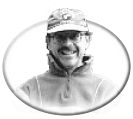
Harvesting the Herring
with
D.C. Reid
It's that crazy time of year again. The time when the herring come home. Like streaks of mercury they home in by the millions to spawn the B.C. coastline from
Victoria
to the Queen Charlotte Islands. And it's a good time to be a herring fisher, from the wily old angler taking a few from a quiet lagoon to the seiners and gillnetters jockeying for position on the spawning grounds.
As fishers, we depend on salmon for our sport. They in return depend for survival on good fat dinners of lower, hapless members of the food chain. For
sockeye
and
chum
the chief quarry is plankton. These lower forms of life as well as larval stages of more highly-evolved creatures float in their billions in the top layer of the water column so dense they can turn the ocean red or slime fishing lines with coatings of brown.
The other species of salmon -
coho
,
chinook
and
pink
- prefer fishier diets. They key in on herring, anchovy, eulachon and sandlance (also known as candlefish). The latter cover mudbottoms like living clouds in depths from 30 - 150'. The other minnows are also schooling fish, but in mid-water regions, and at the surface at first light. All Pacific anglers know the beautiful, mystical, first-light phenomenon of acres and acres of herring dimpling the surface like a rain of diamonds. And it is upon these food stocks that our sport depends.
The herring schools also support their own fishery. Commercial gillnetters and seiners in a fishery as highly orchestrated as a mad ballet swoop on orders from the Department of Fisheries (DFO) and may, in as little as one day, land the entire annual fishery quota - this year set at 36,319 tons. This highly-managed run for the fish may bring as much as $70,000,000 pay to the eager licensees. The product is the female's roe, a highly prized delicacy on Asian markets.
For the health of all fisheries, the February to April herring roe scramble is carefully monitored. All participants must be licenced and fish in established pools. DFO has a committee of representatives from all sectors, including management, conservation, stock assessment, licensing, coast guard and aboriginal fisheries. Then divers are dispatched among the huge schools to assess stock ripeness. Herring are not taken until the absolute peak in quality and then, in a dash, the catch is harvested and rushed to world markets in perfect condition.
For 1998 the herring fishery is targeted in five geographical areas:
Queen Charlotte Islands
,
Prince Rupert
, Central Coast, Strait of Georgia and West Coast of
Vancouver Island
. As sport fishers have an interest in catch rates that conserve herring resources, the exploitation rate of this valued "crop" is 20% or less of forecast harvestable stocks. For sports fishers, this means continued good salmon fishing and a daily limit of 20kg of herring - a huge amount if you've ever tried your hand and rod at the twisting silver masses.
As prime bait food of our sport fishing quarries, every angler should know some herring biology. Herring spawn in late winter with heaviest activity in March. Spawning water averages a frigid 4.4 degrees to a flesh-numbing 10 degrees Celsius. Females produce 9,000 eggs in their second year, a figure that rises to 38,000 for eight year fish. Spawning occurs at shoreline depths from high tide to 36' - depths that make things tricky for the commercial net fishery. The 1.2 - 1.5 mm eggs are very sticky and adhere in great masses to eelgrass, kelp, rocks and pilings. Alas there is no pairing of sexes; instead the whole spawning area erupts in white - milt from the males - in a mass orgiastic display. Fertilization rates are high.
Eggs hatch in 10 days and larval herring, yolk sac attached, head for the bottom to hunt invertebrate eggs, copepods and diatoms. By early summer, the one inch fry migrate in huge surface schools at dusk where they gorge on plankton. In the fall, herring sink into deeper waters and are little evidenced on the fishing grounds for the next 2 - 3 years. Adults range in length from 10 - 13 inches and achieve weights of 6.5 oz (183 gms). Surprisingly, while different brood groups mingle with one another in nursery areas, they exchange few members.
Copepods and euphasid shrimp become the major sources of food; however, as late autumn approaches, feeding among shore-migrating herring ceases. This is a characteristic cycle: fattening in summer and fasting in winter. Ripening of sexual products at the expense of stored oil occurs during this period. It is during late winter that herring, after avoiding salmon all summer, become the target of man-made fisheries: native ones for ceremonial and social and food purposes; sport anglers for roll mops and bait; and, commercial interests to supply the oriental market with dry-salted meat, raw fish, oil, and specially treated herring such as pickled or kippered products - the British treat.
Those herring that find their way back into the sport sector do so as bait. In many places, moochers can purchase bait live for use with banana weights and limber 10 ½' rods. In other areas, whole herring is utilized for cutplugs by motor moochers. Along the entire coast, herring may also be bought for use in trolling, either as whole fish in teaserheads or as flank strips inserted in specially-designed spiraling strip teasers.
|



